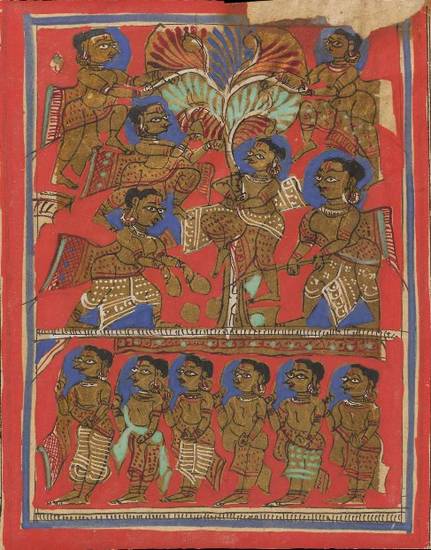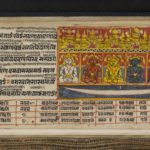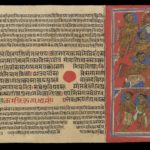Article: Leśyā
In Jainism, leśyā has been described as ‘colour of the soul’, ‘soul-complexion’ or ‘spiritual colouring’ due to its association with karmic matter. The soul – jīva – is sentient and when it is pure does not have material properties of colour, odour, form and taste. However, souls bound with karma and trapped within the cycle of rebirth take on the colour of the leśyā that is characteristic of their spiritual level.
When the soul takes birth – when it is born into a new body in the cycle of rebirth – it is impure and embodied. Certain aspects of the new body are influenced by karma attached to the soul, such as the length of life and physical abilities. Resulting from actions in past births, karma is non-sentient and material in nature. When the soul is embodied, it assumes the colour of the leśyā particles, which are mirrored in the soul, like a crystal reflecting the colour of a nearby object. As the pure and emancipated soul – siddha – has no leśyā, the concept is often understood as meaning ‘karmic stain’.
The six leśyās graduate from black to white, from dark to light, and colour the souls of beings that are subject to karma. They are connected to the past deeds of an individual and indicate his current moral state. The aim of Jain soteriology is for the soul to be purified from contamination by karma, which is necessary to reach final liberation.
Of great significance to the doctrine of Jain karma, leśyā is recognised as crucial by both the Digambara and the Śvetāmbara traditions. This important idea has become familiar to many through the famous ‘parable of the tree’.
Origin of the concept
It is difficult to trace the origin of leśyā in Jainism, as allegorical use of colour has also been made in other South Asian traditions. Modern scholarship compares it with similar concepts in other religions.
A common comparison is with the abhijāti concept of the Ājīvikas. In this ascetic religion led by Makkhali Gośāla, a rival of Mahāvīra, the colours correspond to ‘social classes’. The colours are deterministic, in that ‘a man’s social status is determined by the inborn coloration of the molecules composing his body’ (Tsuchihashi 1983: 202).
In the Brahmanical tradition, as expressed in the Mokṣa-dharma section of the Mahābhārata, there is the similar concept of jīva-varṇa – ‘soul colour’ linked to hierarchically ordered social category (Bedekar 1968: 335ff.).
The six leśyās of Jainism have been compared with the three guṇas, the natural qualities of matter – prakr̥ti – in the Sāṃkhya philosophy of Hinduism (Zimmer 1969 [1990]: 229–230). Establishing a gradation from clear to dark, from pure to very impure, in a way comparable to the leśyās, these three qualities are:
- clear, pure – sattva
- fiery – rajas
- dark – tamas.
In Buddhism there are also colours of deeds – kamma – and the application of colour to the spiritual classification of monks (McDermott 1999: 180–190).
Hence, some scholars argue that it is a concept that has been borrowed and adapted in the Jain doctrine, while others regard this borrowing as ‘well-known’ (Tsuchihashi 1983: 195).
The question of whether it was imported into Jainism does not detract from the importance of leśyā in Jain beliefs.
Meaning of the term
The traditional etymology connects the word leśyā with the root liś or śliṣ, both meaning to ‘adhere’. This agrees with what the word has come to mean in the classical doctrine. For example the 11th-century Śvetāmbara commentator Abhayadeva-sūri explains that ‘leśyā is that by which a living being [soul] is connected with or burned with karma’ in his commentary to the Sthānāṅga-sūtra (Wiley 2000: 351f.). Similar explanations are given by Digambara authors (Jainendra Siddhānta Kośa volume 3: 422).
The idea of something that ‘adheres’, ‘sticks’ or ‘smears’ is also conveyed through another traditional explanation. This connects leśyā and the Sanskrit root limp-, which means ‘to smear’ (Jainendra Siddhānta Kośa volume 3: 422).
It has been shown, however, that the Prakrit word lesā originally meant ‘light’ (Tsuchihashi 1983: 197ff.). Outside doctrinal contexts where it is connected to the karma concept, the word is applied to heavenly bodies such as the sun or moon. It occurs with verbs meaning ‘to shine’ or ‘to radiate’ in various Śvetāmbara canonical works. More precisely, it means ‘substance-like lustre’ or ‘lustre inherent in and concomitant with something solid and concrete’, namely the leśa ‘particle, molecule’ (Tsuchihashi 1983: 201).
Sources
Extensive discussions of the leśyās are found in both Śvetāmbara and Digambara canonical and post-canonical texts and commentaries. Many chapters and passages focus on the leśyās while others that examine karma theory discuss them as part of this key Jain doctrine.
Śvetāmbara works
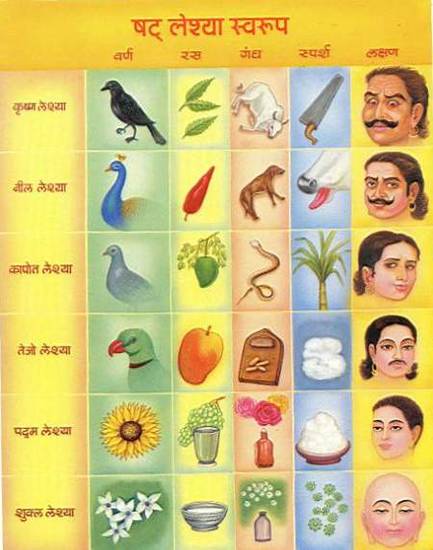
Attributes of the leśyās
Image by Diwakar Prakashan / Padma Prakashan © Diwakar Prakashan / Padma Prakashan
Of the Śvetāmbara canonical works, the 34th chapter of the Uttarādhyayana-sūtra and the 17th chapter of the Prajñāpanā-sūtra are specifically devoted to leśyā (Wiley 2000: 348; Shah 1971: 350–354). These passages deal with all the aspects of the concept.
The Uttarādhyayana chapter contains various poetical metres (Alsdorf 1968: 214–220). It has a minority of ślokas and a majority of āryās. This suggests two stages in its composition. It has been demonstrated that the chapter has a nucleus concerned with leśyā, specifically the:
- names of the six colours
- description of the six colours
- types of activities that cause the various types.
All other information on the attributes of leśyās represents an amplification reflecting ‘a later development of Jaina doctrine’ (Alsdorf 1968: 219). These attributes are:
- taste – rasa
- smell – gandha
- touch – sparśa
- degree of intensity – pariṇāma
- symptom – lakṣaṇa
- variety – sthāna
- duration – sthiti
- result – gati
- lifespan – āyuḥ.
Other canonical texts with material on leśyā are the:
- third Aṅga of the Śvetāmbara canon, the Sthānāṅga-sūtra
- fifth Aṅga, the Viyāha-pannatti, also called the Bhagavatī or Vyākhyā-prajñapti (Schubring 1962 [2000]:196–7; Banthiya 1966).
Śvetāmbara works specifically dedicated to the karma doctrine are another source for the understanding of the concept. They are:
- the six karma-granthas in Prakrit verse, written in particular by Devendra-sūri in the 13th century
- the Pañca-saṃgraha, in Prakrit verses, by Candrarṣi Mahattara
- the Karma-prakṛti, also in Prakrit verses, by Śivaśarma-sūri.
Their main Sanskrit commentaries, written by Malayagiri in the 12th century, are indispensable in understanding them.
Cosmological treatises, such as the kṣetra-samāsas or the saṃgrahaṇīs, also discuss leśyās. Since leśyās are connected to karma, they are instrumental in the forms of rebirths. Hence they are crucial in the place which various beings have in the Jain universe.
The Leśyā Kośa is a 20th-century Hindi encyclopaedia of leśyā that claims to be a comprehensive catalogue of material to date. It is based on Śvetāmbara writings.
Digambara works
The Digambara authoritative scriptures – the Ṣaṭkhaṇḍāgama and the Kaṣāya-prābhṛta – are important sources that discuss the concept extensively (Jainendra Siddhānta Kośa volume 3: 422–428). The accompanying commentaries are also essential to understand the Digambara idea of leśyā.
Six colours
The number of leśyās is fixed as six. The association between the concept and the number is so strong that the word leśyā means the number 6 in the numerical system when words are used instead of digits.
Each of the leśyās is designated by an adjective referring to a colour in a scale going from black to white, from dark to light. But there are variations in the way intermediate colours are understood, and hence in the way they may be represented in paintings, for instance.
Three and three
It is common to draw a clear line separating the leśyās into two groups of three.
The first three are considered non-meritorious because they signal high degrees of:
- passion – kaṣāya
- harmful actions
- deceitfulness.
For instance, here is the behaviour of a man who is characterised by the black leśyā:
A man who acts on the impulse of the five āsravas, does not possess the three guptis, has not ceased to injure the six kinds of living beings, commits cruel acts, is wicked and violent, is afraid of no consequences, is mischievous and does not subdue his senses – a man of such habits develops the black leśyā
Uttarādhyayana-sūtra 34.21–22
Jacobi’s translation 1895: 199
The last three are meritorious because they imply:
- a lower degree of passions
- actions that are as harmless as possible
- true inclination towards good practices.
White signals the highest degree of purity:
A man who abstains from constant thinking about his misery and about sinful deeds, but engages in meditation on the Law and truth only, whose mind is at ease, who controls himself, who practices the samitis and the guptis, whether he be still subject to passion or free from passion, is calm, and subdues his senses – a man of such habits develops the white leśyā
Uttarādhyayana-sūtra 34.31–32
Jacobi’s translation 1895: 200
This is summed up in the following manner:
The black, blue and grey leśyās are the lowest leśyās; through them the soul is brought into miserable courses of life. The red, yellow, and white leśyās are the good leśyās; through them the soul is brought into happy courses of life
Uttarādhyayana-sūtra 34.56–57
Jacobi’s translation 1895: 203
Karma and leśyās
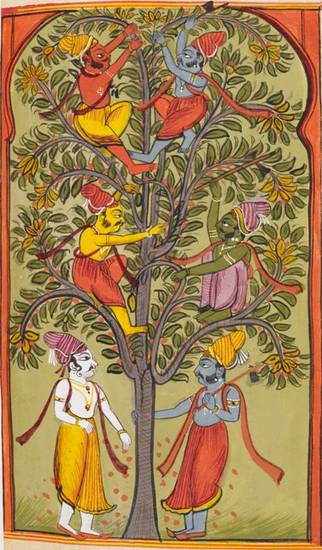
Parable of the tree
Image by British Library © CC0 1.0 (Creative Commons Public Domain)
It can be demonstrated (Malde 2011) that the concept of leśyā plays an important role in Jain karma theory. This goes against Schubring’s contention that ‘…the concept is of secondary nature, and can stay out of the system without leaving a gap in its composition’ (Schubring 1962/2000: 196; see also Wiley 2011: 21).
The concept of leśyā in Jainism has two applications, which may be related to different stages in the development of karma theories.
Firstly, it is used allegorically to grade the purity of the soul. It is thus a useful tool in pedagogical understanding and the transmission of doctrine. The idea itself may have started when the karma doctrine was not fully developed and colour was used to symbolise the quality of soul or deed in early Jain thought. This use is illustrated in parables and links to the classes of deities.
Secondly, the concept gained a technical, ontological application. Once karma was interpreted in terms of the theory of atoms, the allegorical notion of colours’ association with certain actions was explained as a material property of karmic matter. Hence as the karma doctrine became more sophisticated, so did the concept of leśyā (Tatia 1966: 22). Jain ontology accepts dual reality, that of soul and matter. It is their union that gives colour to the soul. This joining together of soul and karmic particles is the cause of samsāra – the cycle of rebirths. When karmic matter becomes stuck to the soul, it changes it in various ways. One of these changes is an alteration in colour, which is its leśyā. Hence the frequent definition of leśyā as ‘karmic stain’.
Parables
Two parables demonstrate the allegorical application of the concept of leśyā. As the basis of Jain philosophy is to avoid all kinds of sinful activity, these stories use colour to grade sinful activity. Found in the karma-granthas, they have been transmitted down the centuries in cosmological works and wider literature, oral tradition and manuscript paintings. They are a common heritage for all Jain sects.
Parable of the tree
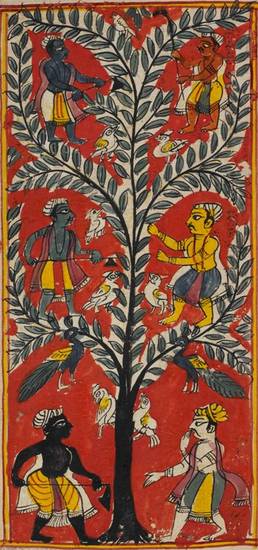
Parable of the tree
Image by British Library © CC0 1.0 (Creative Commons Public Domain)
Six men see a jambū or rose-apple tree, full of ripe fruit. They want to eat the fruit but climbing the tall tree is dangerous. They think about how they can fetch the rose-apples. Their ideas are linked to the six colours of the leśyās.
|
Idea |
Leśyā colour |
|
|---|---|---|
|
1 |
kill all beings, quadrupeds and bipeds |
black |
|
2 |
kill all human beings |
dark (blue) |
|
3 |
kill all men |
grey |
|
4 |
kill all armed men |
fiery |
|
5 |
kill all armed men who fight |
lotus-pink |
|
6 |
steal valuables, but not murder anybody |
white |
Groups of gods and leśyās
Chapter 4 of the Tattvārtha-sūtra also shows how colours of leśyās are explicitly used as shorthand for moral conditions. In this chapter (4.2, 4.7, 4.21, 4.23) the leśyās are connected with each of the four classes – nikāyas – of gods – devas. With darker leśyās assigned to gods in the lower regions of the upper world, the leśyās get progressively purer for divinities in the higher regions of the upper world.
There are differences between Śvetāmbaras and Digambaras in the understanding of this point and therefore in the sectarian versions of the Tattvārtha-sūtra.
The Śvetāmbara text reads: ‘the third [class of gods] is of yellow colour’ – tṛtīyaḥ pīta-leśya iti.
The Digambara version reads: ‘in the three [classes of gods] from the beginning, the colours up to yellow’ – āditas triṣu pītānta-leśyāḥ.
|
Class of gods |
Śvetāmbara leśyās |
Digambara leśyās |
|---|---|---|
|
Bhavanavāsins |
|
|
|
Vyantaras |
|
|
|
Jyotiṣkas |
|
|
|
Vaimānikas |
|
|
The same point is discussed in the cosmological works known as saṃgrahaṇīs, namely which leśyā(s) do the different groups of gods have? The list of six colours is given on this occasion, and it is in this context that the concept is illustrated through paintings of the parable of the tree.
More generally, the exposition on leśyā implies discussing which and how many types are possible in which form of existence (Prajñāpanā: table in Shah 1971: 351). Souls of beings born in hells have black, blue or grey colours. Inferior varieties of animals are treated like the Vyantara gods.
The full range of leśyās is found among human beings. This is why it is connected with the human destiny – manuṣya-gati. It is also found in animals born from a womb.
Reading
- The Āryā Stanzas of the Uttarajjhāyā: Contributions to the Text History and Interpretation of a Canonical Jaina Text
Ludwig Alsdorf - Abhandlungen der Geistes- und Sozialwissenschaftlichen Klasse series; volume 2
Akademie der Wissenschaften und der Literatur Mainz; Wiesbaden, Hesse, Germany; 1966
- Leśyā Kośa: Cyclopaedia of leśyā
Mohanlāla Bāṇṭhiyā and Śricanda Coraṛiyā - Jaina Vishaya-Kośa granthamālā series
Mohanlāla Bāṇṭhiyā; Calcutta, West Bengal, India; 1966
- History and doctrines of the Ājīvikas: a vanished Indian religion
Arthur L. Basham - Luzac; London, UK; 1951
- ‘The Doctrine of the Colours of Souls in the Mahābhārata: Its Characteristics and Implications’
V. M. Bedekar - Annals of the Bhandarkar Oriental Research Institute
volume 48–49
Bhandarkar Oriental Research Institute; 1968
- ‘The Colours of the Soul and the Origin of Karmic Eschatology’
Erik Af Edholm - On the Meaning of Death: Essays on Mortuary Rituals and Eschatological Beliefs
edited by Sven Cederroth, Claes Corlin and Jan Lindström
Uppsala Studies in Cultural Anthropology series; volume 8
Upsaliensis Academiae; Uppsala and Stockholm, Sweden; 1988
- The Jaina Path of Purification
Padmanabh S. Jaini - University of California Press; Berkeley, California USA; 1979
- Die Kosmographie der Inder: nach den Quellen dargestellt
Willibald Kirfel - Georg Olms; Hildesheim, Lower Saxony, Germany; 1967
- Samayasāra of Śrī Kundakunda
Kundakunda - translated by Appaswami Chakravarti
edited by A. N. Upadhye
Bhāratīya Jñānapītha Mūrtidevī Jaina granthamālā: English series; volume 1
Bhāratīya Jñānapīṭha; Banaras, Uttar Pradesh, India; 1971
- ‘The Concept of Leśyā in Jaina Literature’
Shruti Malde - Jaina Studies: Newsletter of the Centre of Jaina Studies
edited by Peter Flügel
Centre of Jaina Studies, SOAS; London, UK; March 2011
- ‘Karma and Rebirth in Early Buddhism’
James P. McDermott - Karma and Rebirth in Classical Indian Tradition
edited by Wendy Doniger O’Flaherty
University of California Press; Berkeley, California, USA; 1980
- Manuscript Illustrations of the Uttarādhyayana Sūtra
W. Norman Brown - American Oriental series; volume 21
American Oriental Society; New Haven, Connecticut USA; 1941
- The Doctrine of the Jainas: Described after the Old Sources
Walther Schubring - translated by Wolfgang Bühlen
edited by Satya Ranjan Banerjee
Lala Sunder Lal Jain Research series; volume 15
Motilal Banarsidass; New Delhi, India; 2000
- That Which Is: Tattvārtha Sūtra
Umāsvāti / Umāsvāmi - translated by Nathmal Tatia
Sacred Literature series
International Sacred Literature Trust in association with Harper Collins; London, UK; 1994
- ‘On the literal meaning of leśyā’
Kyōshu Tsuchihashi - Indologica Taurinensia
edited by Nalini Balbir and Colette Caillat
volume 11
International Association of Sanskrit Studies; 1983
- ‘Colours of the Soul: By-Products of Activity or Passions?’
Kristi L. Wiley - Philosophy East and West
edited by Kim Skoog
volume 50: 3
University of Hawai'i Press; 2000
- Historical Dictionary of Jainism
Kristi L. Wiley - Historical Dictionaries of Religions, Philosophies, and Movements series; series editor Jon Woronoff; volume 53
Scarecrow Press; Maryland, USA; 2004
- ‘The Significance of adhyavasāya in Jain Karma Theory’
Kristi L. Wiley - International Journal of Jaina Studies (Online)
edited by Peter Flügel
volume 7: 3
Centre of Jaina Studies, SOAS; London, UK; 2011
- Philosophies of India
Heinrich Zimmer - edited by Joseph Campbell
Motilal Banarsidass; New Delhi, India; 1990
Links
- Definition of leśyā
-
The concept of leśyā, a fundamental part of the doctrine of karma, is defined in Wikipedia.
- Leśyās
-
A definition of the concept of karmic stain or soul colour – leśyā – on the HereNow4U website.
- Karma, passions and karmic stain
-
Jinalaya.com provides a detailed explanation of the complex doctrine of karma in the Jain faith, including the related notions of passions – kaṣāyas – and 'karmic stain' – leśyā – which indicates a soul's spiritual condition.
- Parable of the tree
-
Jain Square recounts the well-known parable of the tree, which shows how actions indicate the colour of the soul – leśyā. This karmic stain or soul colour reflects the soul's spiritual condition.
https://jainsquare.wordpress.com/2011/06/27/six-friends-and-mango-tree-illustration-lesya/
- King Shrenik hears about leśyā
-
Jain Square offers the story of King Shrenik, who hears an illustration of the concept of karmic stain or soul colour – leśyā – from the 24th Jina. Mahāvīra explains how the colour of the embodied soul changes according to its mental and spiritual condition. This affects the progress of the soul through the cycle of rebirth.
https://jainsquare.wordpress.com/2011/06/27/king-shrenik-illustration-lesya/
- Basis for the Classification of Leshya
-
HereNow4U provides an extract from Transmutation Of Personality Through Preksha Meditation that discusses the categories of leśyā or soul colour. The extract takes the form of an interview with Ācārya Tulsi, the eighth leader of the Śvetāmbara Terāpanthin sect. Although he uses scripture to explain leśyās, Ācārya Tulsi considers the concept partly in the context of the 'insight meditation' – prekṣā dhyāna – of the Śvetāmbara Terāpanthins, which may also be practised by those who do not follow this sect.
- Taste, Smell and Touch Therapy
-
HereNow4U provides an extract from Transmutation Of Personality Through Preksha Meditation that discusses the material nature of the concept of leśyā or soul colour. The excerpt takes the form of an interview with Ācārya Tulsi, the eighth leader of the Śvetāmbara Terāpanthin sect. Although he uses scripture to explain leśyās, Ācārya Tulsi considers the concept partly in the context of the 'insight meditation' – prekṣā dhyāna – of the Śvetāmbara Terāpanthins, which may also be practised by those who do not follow this sect.
- Identification of the Aura and the Current of Feeling
-
HereNow4U provides an excerpt from Transmutation Of Personality Through Preksha Meditation that briefly discusses the qualities of leśyā or soul colour. The excerpt takes the form of an interview with Ācārya Tulsi, the eighth leader of the Śvetāmbara Terāpanthin sect. Although he uses scripture to explain leśyās, Ācārya Tulsi considers the concept partly in the context of the 'insight meditation' – prekṣā dhyāna – of the Śvetāmbara Terāpanthins, which may also be practised by those who do not follow this sect.
- +
- aAbhavya
- aAbhinandana
- aAbhiṣeka
- aĀcāra
- aĀcārāṅga-sūtra
- aĀcārya
- aAchalbhrata
- aAḍhāī-dvīpa
- aAdharma
- aAdho-loka
- aAdhyayana
- aAdvaita Vedānta
- aĀgama
- aAghātīya
- aAghātīya-karman
- aAgnibhuti
- aAgra
- aĀhāra
- aAhiṃsā
- aAhimsa Day
- aAjita
- aAjīva
- aAkampit
- aĀkāśa
- aAkbar the Great
- aAkṣaya-tṛtīyā
- aAlauddin Khalji
- aAlbert Einstein
- aAllah
- aAlms
- aĀlocanā
- aAloka-ākāśa
- aAmāri
- aAmbikā or Kūṣmāṇḍinī
- aAnagāra
- aAnanta
- aAnarthadaṇḍa
- aAnaśana
- aAnekānta-vāda
- aAṅga
- aAniconism
- aAnojjā
- aAntarāla
- aAntarāya-karma
- aAṇu
- aAṇu-vrata
- aAnukampā
- aAnuprekṣā
- aAnusvāra
- aApabhraṃśa
- aAparigraha
- aAra
- aĀrambha
- aĀrambhaja
- aĀratī
- aArdhamāgadhī Prākrit
- aArhaṃ
- aArhat
- aArśana-āvaraṇīya-karma
- aĀrta-dhyāna
- aĀryikā
- aĀryikā Jñānamati
- aĀśātanā
- aĀścarya
- aAscetic
- aAsceticism
- aAshram
- aAspiration
- aĀsrava
- aAṣṭa-maṅgala
- aAṣṭāpada
- aAstikāya
- aAstrolabe
- aAsura
- aAtheism
- aAticāra
- aAtiśayakṣetra
- aAtithisaṃvibhāgavrata
- aĀtma-vāda
- aĀtman
- aAuṃ
- aAurangzeb
- aAuspicious
- aAusterity
- aAvadhāna
- aAvadhi-jñāna
- aĀvaraṇī-yakarman
- aAvasarpiṇī
- aAvatāra
- aAvidyā
- aAxiom
- aĀyāga-paṭa
- aĀyambil
- aĀyu-karma
- aĀyurveda
- bBabur
- bBāhubali
- bBaladeva
- bBālāvabodha
- bBandha
- bBasadi
- bBazaar
- bBhadrankarvijay
- bBhagavant
- bBhaktāmara-stotra
- bBhakti
- bBhale
- bBharata
- bBhāṣā
- bBhāṣya
- bBhaṭṭāraka
- bBhāva
- bBhāva-pūjā
- bBhāvanā
- bBhavana-vāsin
- bBhavya
- bBhavyatva
- bBhaya
- bBhoga-bhūmi
- bBhogopabhoga
- bBodhi
- bBollywood
- bBrahmā
- bBrahma-deva
- bBrahmacārī
- bBrāhmaṇa
- bBraj Bhāṣā
- bBright fortnight
- bBritish Raj
- bBuddha
- bBuddhi-sagar
- bBuddhism
- bBuddhist
- cCaitya
- cCaityavāsin
- cCakravartin
- cCakreśvarī
- cCāmara
- cCandanā
- cCandragupta
- cCandraprabha
- cCanon
- cCāritra
- cCāritramohanīya-karman
- cCarũrī
- cCaste
- cCaturvidha-saṅgha
- cCaturviṃśati-stava
- cCāturyāma
- cCE
- cCelibacy
- cCha
- cChadmastha
- cChastity
- cCheda-sūtra
- cChristian
- cChristianity
- cClergy
- cCloning
- cColophon
- cCommentary
- cConch
- cConfession
- cCongregation
- cConsecration
- cCosmology
- cCremation
- cCrore
- cCult
- cCūrṇi
- dDādā-guru
- dDalit
- dDāna
- dDaṇḍa
- dDark fortnight
- dDarśana
- dDarśanamohanī-yakarman
- dDaśa-lakṣaṇa-parvan
- dDeity
- dDelhi Sultanate
- dDerāsar
- dDeśāvakāśika-vrata
- dDetachment
- dDevanāgarī
- dDevānandā
- dDevarddhi-gani
- dDevotee
- dDhamal
- dDhanuṣ
- dDhāra
- dDharma
- dDharma-dhyāna
- dDharma-sāgara
- dDharmastikaya
- dDhātakīkhaṇḍa
- dDholak
- dDhyāna
- dDiaspora
- dDig-vrata
- dDigambara
- dDīkṣā
- dDisciple
- dDīvālī
- dDivya-dhvani
- dDNA
- dDoctrine
- dDogma
- dDonor
- dDoṣa
- dDravya
- dDravya-pūjā
- dDrone
- dDuṣamā
- dDuṣamā-duṣamā
- dDuṣamā-suṣamā
- dDveṣa
- dDvīpa
- eEast India Company
- eEightfold Path
- eEkānta-vāda
- eEkendriya
- eElder
- eElders
- eEschatology
- eEtc up to
- fFarmān
- fFast
- fFatehpur Sikri
- fFestival
- fFestschrift
- fFiruz Shah
- fFly-Whisks
- fFolio
- fFour Noble Truths
- gGaccha
- gGaṇa
- gGaṇadhara
- gGanadharavada
- gGaṇeśa
- gGaṇin
- gGarba
- gGarbha
- gGarbha-gṛha
- gGaruḍa
- gGati
- gGene
- gGenomics
- gGhātī-yakarman
- gGhātīya
- gGhaznavid
- gGhiyasuddin Tughlaq
- gGhurid
- gGloss
- gGotra-karma
- gGujarāt
- gGujarati
- gGuṇa
- gGuṇa-sthāna
- gGuṇa-vrata
- gGupti
- gGuru
- gGuruṇī
- hHagiography
- hHajj
- hHaṃsa
- hHaribhadra
- hHariṇaigameṣin
- hHasta
- hHeresy
- hHiṃsā
- hHindi
- hHindu
- hHinduism
- hHīravijaya
- hHoroscope
- hHrīṃ
- hHumayun
- hHymn
- iIconoclasm
- iIconography
- iIdol
- iIndian Independence
- iIndology
- iIndra
- iIndrabhūti Gautama
- iIndriya
- iInitiation
- iIntercession
- iInvocation
- iIQ
- iIslam
- iIslamicate
- iIṣṭadevatā
- iĪśvara
- jJagat
- jJahangir
- jJain
- jJaina Devanāgarī
- jJaina Śaurasenī
- jJaina-dharma
- jJainaśāsana
- jJainness
- jJaisalmer
- jJamāli
- jJambū-dvīpa
- jJames Burgess
- jJanma
- jJanma-kalyāṇa
- jJarā
- jJāti
- jJina
- jJina-āgama
- jJina-bhavana
- jJina-bimba
- jJina-mātā
- jJinacandra-sūri
- jJinadatta
- jJinaprabha
- jJīva
- jJñāna
- jJñāna-āvaraṇīya-karma
- jJñāna-āvarṇiya
- jJñānsundar
- jJyotiṣka
- kKāla
- kKālakācārya-kathā
- kKālidāsa
- kKalpa-sūtra
- kKalpa-vṛkṣa
- kKalyāṇaka
- kKalyanvijay
- kKamaṇḍalu
- kKamaṭha
- kKarma
- kKarma-bhūmi
- kKarma-grantha
- kKarma-prakṛti
- kKarma-vāda
- kKarmon
- kKarnataka
- kKaṣāya
- kKathā
- kKāvya
- kKāya
- kKāyotsarga
- kKeśa-loca
- kKetu
- kKevala-jñāna
- kKevalin
- kKhalji
- kKharatara-gaccha
- kKnowledge
- kKriyā
- kKriyā-vāda
- kKṛṣṇa
- kKṣamā-śramaṇa
- kKṣapakaśreṇi
- kKṣatriya
- kKṣullaka
- kKulakara
- kKundakunda
- kKunthu
- lLabdhi
- lLaity
- lLakh
- lLāñchana
- lLands of Action
- lLaukāntika
- lLavaṇa-samudra
- lLeśyā
- lLiṅga
- lLinguistics
- lLoka
- lLoka-ākāśa
- lLoka-puruṣa
- lLoka-vāda
- lLotus
- lLotus lake
- mMadhya-loka
- mMahā-videha
- mMahā-vrata
- mMahābhārata
- mMahāmastakābhiṣeka
- mMāhārāṣṭra
- mMāhārāṣṭrī Prākrit
- mMahattarā Yākinī
- mMahāvīr Jayantī
- mMahāvīra
- mMakāra
- mMakkhali Gośāla
- mMalli
- mMāna-stambha
- mManaḥ-paryāya-jñāna
- mMaṇḍala
- mMaṇḍapa
- mMandit
- mMaṅgala
- mMantra
- mMantras
- mManuṣya-loka
- mMarāṭhī
- mMārgaṇā
- mMartyr
- mMarudevī
- mMaṭha
- mMati-jñāna
- mMauryaputra
- mMecca
- mMendicant lineage
- mMetarya
- mMiracle
- mMithyādṛṣṭi
- mMohandas Gandhi
- mMohanīya-karma
- mMokṣa
- mMonastic order
- mMonasticism
- mMonk
- mMonotheism
- mMosque
- mMount Meru
- mMount Sammeta
- mMṛgāvatī
- mMughal
- mMuhammad
- mMuhammad bin Tughlaq
- mMuhpattī
- mMūla-sūtra
- mMūlaguṇa
- mMumbaī
- mMuni
- mMunisuvrata
- mMurad Bakhsh
- mMūrti-pūjaka
- mMuslim
- mMysticism
- nNābhi
- nNāga-kal
- nNāgapurīya Tapā-gaccha
- nNāgarī
- nNāma-karma
- nNamaskāra-mantra
- nNami
- nNandīśvara-dvīpa
- nNandivardhana
- nNandyāvarta
- nNāraka
- nNāraki
- nNasalisation
- nNātha
- nNavrātrī
- nNaya-vāda
- nNemi
- nNidāna
- nniggaṃthāṇa vā 2
- nniggaṃtho vā 2
- nNigoda
- nNihnava
- nNikṣepa
- nNirgrantha
- nNirjarā
- nNirvāṇa
- nNiryukti
- nNiṣidhi
- nNitya
- nNiyati
- nNo-kaṣāya
- nNudity
- nNun
- oOcean of milk
- oOmniscience
- oOrdination
- ppa°
- pPadmaprabha
- pPadmāsana
- pPadmāvatī
- pPādukā
- pPalanquin
- pPalette
- pPañca-muṣṭi
- pPāṇḍava
- pPaṇḍit
- pPandit Dalsukh D. Malvania
- pPandit Sukhlalji
- pPāṇipātra
- pPāpa
- pParamātman
- pParameṣṭhin
- pPāraṇā
- pParigraha
- pPariṇāma
- pParīṣaha
- pParokṣa
- pPārśva
- pPārśvanātha
- pParyāya
- pParyuṣaṇ
- pPaṭa
- pPatan
- pPātra
- pPenance
- pPersian
- pPhala
- pPhilology
- pPicchikā
- pPilgrimage
- pPīr
- pPolymath
- pPoṣadha
- pPossession
- pPothī
- pPrabhas
- pPradakṣiṇā
- pPradeśa
- pPrākāra
- pPrakīrṇaka-sūtra
- pPrākrit
- pPramāda
- pPramukhā
- pPrati-vāsudeva
- pPratikramaṇa
- pPratimā
- pPratiṣṭhā
- pPratyākhyāna
- pPratyakṣa
- pPravacana
- pPrāyaścitta
- pPrayer
- pPre-modern
- pPreach
- pPredestination
- pProtestant
- pProvenance
- pPudgala
- pPūjā
- pPujārī
- pPukharavara-dvīpa
- pPuṇya
- pPūrva
- pPuṣkara-dvīpa
- pPuṣpadanta
- pPyre
- qQur’an
- rRāga
- rRāhu
- rRainy season
- rRajasthan
- rRajasthani
- rRājimatī
- rRajoharaṇa
- rRajput
- rRāma
- rRāmāyaṇa
- rRangoli
- rRās-garbā
- rRasa
- rRathanemi
- rRatna-traya
- rRātri-bhojana
- rRaudra-dhyāna
- rRecto
- rRelic
- rRenunciation
- rRetroflex
- rRevatī
- %Ṛg-veda
- rRite
- rRosary
- %Ṛṣabha
- %Ṛṣabhanātha
- rRupee
- sSaciyā Mātā
- sSādhu
- sSādhvī
- sSāgāra
- sSaint
- sŚaivaism
- sŚaka-saṃvat
- sSallekhanā
- sŚalya
- sSamacatuṣṭha
- sSamādhimaraṇa
- sSamaṇi
- sSāmarambha
- sSamavasaraṇa
- sSāmāyika
- sSaṃbhava
- sSamiti
- sSaṃjñā
- sSaṃkalpaja
- sSaṃsāra
- sSamudghāta
- sSaṃvara
- sSaṃvega
- sSamyak-cāritra
- sSamyak-darśana
- sSamyak-jñāna
- sSamyaktva
- sSaṃyama
- sSanctuary
- sSandalwood
- sSaṇgha
- sSanskrit
- sSant
- sŚānti
- sSapta-bhaṅgi-naya
- sSārambha
- sSarasvatī
- sSarvajña
- sSāsan-devi
- sŚāsana-devatā
- sŚāstra
- %Ṣaṭ-jīvanikāya
- sSatī
- sSatīmātā
- sSatya
- sSchism
- sScribe
- sScripture
- sSect
- sSecularism
- sŚenāī
- sSermon
- sŚeṣavatī
- sSevā
- sSeven fields of donation
- sShah Jahan
- sShantidas Jhaveri
- sShrine
- sSiddha
- sSiddha-śilā
- sSiddhacakra or Navadevatā
- sSiddhānta
- sSiddhārtha
- sSiddhi
- sSikh
- sSikhism
- sŚikṣā-vrata
- sŚīla
- sSin
- sSindh
- sŚītala
- sŚiva
- sSkandha
- sSomanatha
- sŚraddhā
- sŚramaṇa
- sŚrāvaka
- sŚrāvakācāra
- sŚrāvikā
- sŚreyāṃsa
- sŚrī
- sŚrīvatsa
- sŚruta-jñāna
- sŚruta-pañcamī
- sSthānaka-vāsin
- sSthāpanācārya
- sSthāvara
- sSthavira
- sSthiti
- sStrīmukti
- sStūpa
- sSubcontinent
- sSudarshana
- sŚuddhi
- sSudharma
- sŚūdra
- sSufism
- sSukha
- sŚukla-dhyāna
- sSulasā
- sSultan
- sSumati
- sSundarśrī
- sSupārśva
- sSūri
- sSuṣamā
- sSuṣamā-duṣamā
- sSuṣamā-suṣamā
- sSūtra
- sSuyam me ausam! Tenam bhagavaya evamakkhayam
- sSvādhyāya
- sSvāhā
- sSvastika
- sŚvetāmbara
- sŚvetāmbara Terāpanthin
- sŚvetāmbaras
- sSwan
- sSyād-vāda
- tTabla
- tTantra
- tTapā-gaccha
- tTapas
- tTāraṇ Svāmī Panth
- tTattva
- tTattvārtha-sūtra
- tTemple
- tTemple-city
- tThe Enlightenment
- tTheology
- tThree worlds
- %Ṭīkā
- tTilaka
- tTīrtha
- tTīrthaṃkaranāma-karman
- tTīrthankara
- tTransliteration
- tTrasa
- tTrasa-nāḍī
- tTriśalā
- tTriṣaṣṭi-śalākā-puruṣa-caritra
- tTti bemi
- tTughlaq
- tTunk
- uUdumbara
- uUniversal History
- uUpādhyāya
- uUpāṅga
- uUpaniṣads
- uUpāsaka
- uUpasarga
- uUpāśraya
- uŪrdhva-loka
- uUtsarpiṇī
- uUttarādhyayana-sūtra
- vVāhana
- vVaimānika
- vVairāgya
- vVaiṣṇava
- vVaiśramaṇa
- vVaiśya
- vValabhī
- vVanaspatikāya
- vVandana
- vVaṇik
- vVarṇa
- vVāsudeva
- vVāsupūjya
- vVayubhūti
- vVeda
- vVedanīya-karma
- vVegetarianism
- vVehicle
- vVernacular
- vVerso
- vVidyā
- vVidyā-devī
- vVihāra
- vVijñapti-patra
- vVikrama-saṃvat
- vVikṛti
- vVimala
- vVinaya
- vVipāka
- vVirji Vora
- vVirodhaja
- vVīrya
- vVisarga
- vViṣṇu
- vVītarāga
- vVizier
- vVotive
- vVow
- vVrata
- vVS
- vVyakta
- vVyantara
- vVyasana
- yYakṣa
- yYakṣī
- yYantra
- yYaśoda
- yYaśovijaya
- yYati
- yYātrā
- yYoga
- yYoginī
- yYojana


